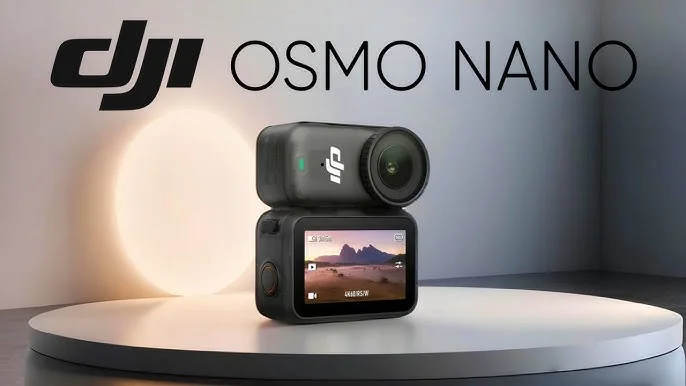Table of Contents
DJI Osmo Nano Review: A Tiny Camera With Big Ambitions
At Squaredtech, we follow every move in the fast-growing action camera market, where portability, performance, and creative freedom are driving rapid innovation. The latest product in this race is the DJI Osmo Nano, a mini action camera priced at $299 that aims to take on Insta360’s Go 3S and Go Ultra.
DJI has long been respected for drones and stabilized cameras, but in action cams, the company has usually followed GoPro and Insta360. The Osmo Nano is a clear example. It borrows the concept of a detachable lens module, pioneered by Insta360’s Go series, but adds its own twist with unique mounting and solid video performance.
The question is whether DJI has finally produced a serious rival to Insta360 in the ultra-compact category. In this DJI Osmo Nano review, Squaredtech breaks down the design, features, performance, and video quality to see how it stacks up.
Size, Build, and Everyday Use
The DJI Osmo Nano is built for daily use in situations where a traditional action camera feels bulky. The tiny main camera weighs just 1.83 ounces (52 grams) and can be worn on the body, clipped to a hat, or even attached to pets for creative footage.
Its translucent plastic body is compact but feels durable enough for outdoor activities. With a 33-foot (10-meter) waterproof rating, the Nano is ready for swimming, surfing, or rainy hikes without needing extra housing.
When paired with the Vision Dock display module, the Nano works like a regular action camera. Together, the camera and screen weigh 4.37 ounces, still lighter than most GoPros or DJI’s own Action 5 Pro. The dock connects magnetically, letting users switch between forward-facing action shots and backward-facing vlogging. However, switching orientation requires detaching and reconnecting, unlike Insta360’s simple flip-screen system.
DJI’s magnetic mount system is familiar from its past products and works smoothly with accessories like a new hat clip and lanyard. Wireless control from the dock extends up to 33 feet, giving users flexibility during shoots.
Squaredtech’s editors noticed the Nano is slightly larger than Insta360’s Go 3S but very close to the Go Ultra in weight and handling. The extra size is explained by the sensor, which we’ll cover shortly.
Features, Controls, and Storage Options
The DJI Osmo Nano review shows that simplicity is central to its design. The main camera has a single button for power and recording. The Vision Dock handles everything else, from video resolution to stabilization modes. The touchscreen interface uses swipes and taps, which work well once you get used to the small display.
DJI includes many useful features for creators:
- Voice and gesture control for hands-free recording
- Timelapse and Pre-Rec modes to capture key moments
- DJI Mic compatibility for professional audio recording
- RockSteady stabilization for reducing shake
- D-LogM capture for advanced color grading
The Osmo Nano comes with built-in memory, an advantage over Insta360 rivals. Users can choose 64GB or 128GB models, with transfer speeds of 400 MB/s and 600 MB/s respectively. This eliminates the need for microSD cards, though some creators may still prefer expandable storage.
Battery life is another key factor. The camera’s 530mAh battery lasts around 90 minutes on its own, while the dock’s 1,300mAh battery extends usage up to 200 minutes in lower settings. At 4K 60fps, however, Squaredtech found that actual run times dropped to around 35 minutes for the camera alone. Overheating was also an issue during long 4K recordings, with shutdowns after 20 minutes.
Charging is handled through the dock, with fast charging reaching 80 percent in about 20 minutes. A full charge for both modules takes around an hour.
In daily testing, Squaredtech editors found the Nano’s controls responsive but less intuitive than Insta360’s streamlined menus. The editing workflow also lags behind, with DJI’s Mimo app offering fewer creative tools than Insta360’s Studio.
Video Quality and Low-Light Performance
The strongest part of this DJI Osmo Nano review is the camera’s impressive video quality. Equipped with a 1/1.3-inch sensor, the Nano captures sharp, colorful footage at 4K up to 60fps, with slow motion at 120fps. This outperforms Insta360’s Go 3S, which tops out at 4K 30fps, and matches the Go Ultra in most modes.
The lens offers a 143-degree field of view, wider than Go 3S but slightly narrower than Go Ultra. Squaredtech found this range to be a good balance, giving immersive wide shots without excessive distortion.
In daylight, footage looks crisp with accurate colors. DJI toned down the over-sharpening seen in earlier models like the Action 5, resulting in more natural textures. Dynamic range is excellent in D-LogM mode, which allows up to 13.5 stops when graded.
Low-light shooting is where the Nano shows its strength over the Go 3S, thanks to the larger sensor. Nighttime city shots and indoor footage showed lower noise levels and better clarity. DJI also includes a SuperNight mode, similar to Insta360’s PureVideo, which merges frames for cleaner results. Still, motion blur was noticeable during fast movements in dark conditions.
Stabilization is handled by RockSteady 3.0, which works well in daylight but struggles in low light where slower shutter speeds cause blur. Squaredtech recommends boosting ISO or shutter speed manually for night shooting. HorizonBalancing, another DJI feature, keeps footage level even when tilted up to 30 degrees.
For creators focused on sound, the Nano integrates with DJI’s professional microphones. Dual built-in mics provide stereo sound, but external DJI mics deliver far superior quality for voices and interviews.
Price, Value, and Final Verdict
At $299 for the 64GB version and $329 for 128GB, the DJI Osmo Nano is significantly cheaper than Insta360’s Go Ultra, which costs €429 with fewer included accessories. The Go 3S sits closer in price but offers weaker video performance. DJI includes the Vision Dock, magnetic mounts, protective case, and charging cable in its package, giving buyers strong value for the price.
From Squaredtech’s perspective, DJI made smart trade-offs with the Osmo Nano. Video quality is excellent for its size, and the detachable design adds creative shooting options. However, shortcomings in stabilization, app editing, and ergonomics show that DJI is still playing catch-up to Insta360.
The DJI Osmo Nano review makes one thing clear: DJI is serious about competing in compact action cameras. For users who prioritize sharp 4K video, easy portability, and strong pricing, the Nano is one of the most attractive mini cameras on the market today. But for creators who need the smoothest stabilization or the most advanced editing tools, Insta360 still holds an advantage.
Stay Updated: Gadgets


